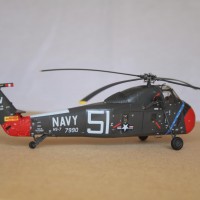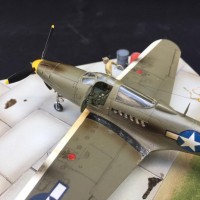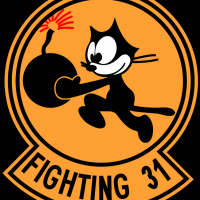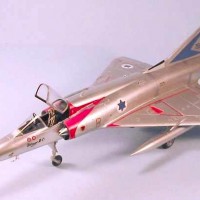P-47C
Here's my latest build from Dora Wings, the P-47C in 1:48. It's OOB except for Eduard belts and harness and stainless micro tubing gun barrels. I finished it with the last of my Model Master OD and used the markings of Hub Zemke's “Moi Tovarich”. I always wondered why a good American Montana boy would choose a Russian name for his aircraft until I did a little research.
Herbert Zemke was born to German immigrant parents in Missoula, Montana in March of 1914, so grew up speaking fluent German. He attended the University Montana studying forestry on football and boxing scholarships. At the time he had no interest in aviation. In 1936 some friends convinced him to try out for pilot training in the United States Army Air Corps. He was accepted as a pilot cadet and earned his wings and a commission at Randolph Field, then attended the pursuit pilot course at Kelly Field and became a P-40 test pilot with the 36th Pursuit Squadron at Langley Field. In 1940 he was sent to England as an observer studying the tactics of the RAF and Luftwaffe - observations he would later use when the US entered the war. In 1941 he was sent to the Soviet Union to train Soviet pilots to fly lend-lease P-40s, where he picked up his Russian language knowledge. In February of 1942 he returned to the US and had several temporary assignments, one of which was testing the new P-47 Thunderbolt. By then a Major, he became Group Commander of the 56th Fighter Group, the first unit to fly the P-47. By then he was a priceless commodity to the US in this new war as he had spent the previous two years training British, Russian, and Chinese pilots to fly the P-40. He was soon promoted to Lieutenant Colonel. He was not impressed with the P-47, it was heavy, lacked the maneuverability of a dogfighter, and had slow acceleration. However, nothing in the sky could dive like a P-47, it was built like a tank and could take punishment, and it had awesome firepower. So, Zemke perfected tactics to utilize those traits and the 56th Fighter Group, later known as Zemke's Wolf Pack, went on to great success and fame producing no fewer than 38 Aces. As the war progressed, the P-51s began taking the lead in escorting the bombers and the P-47s were increasingly shifting to ground attack duties. There was too much of the gladiator in Zemke to be satisfied with shooting up locomotives and parked airplanes. When the commander of the new 479th Fighter Group was killed in action, Zemke applied to fill the vacancy and was quickly accepted. By then he was a full Colonel and began flying the P-51 and was bringing the rookies of the 479th up to his standards.
In October Zemke was informed that he was slated for a desk job, which he detested. His office was the cockpit of a fighter! Later, as he was cruising home from a mission with two of his pilots a Me-262 attacked them. Pushing their Merlin engines to their limits, the trio of Americans underwent some violent maneuvers and gyrations to avoid the jet's passes until the German ran low on fuel and went away. Unknown to Zemke, during the violent maneuvers to avoid the 262 attack, the structural integrity if his Mustang was compromised. When he lifted off for his last mission on October 30 he was escorting a group of Liberators. The weather guessers were wrong, and the Liberators flew into an enormous cloud bank and he had no choice but to follow. When the Mustangs began bucking violently in the severe turbulence Zemke ordered a heading reversal. When he turned, his Mustang nosed over into a spin and as he tried to recover the starboard wing buckled and slammed against the fuselage. As he was contemplating bailing out, the airplane simply disintegrated around him and he was falling still strapped to his seat. After getting loose from the seat, he found that his right arm was injured and he had to pull the ripcord ring with his left arm. That must have been some parachute ride in that turbulence!
After evading and heading westward for two miserable days with an injured arm and leg, he was captured. The Germans were intrigued by this young American Colonel who was so proficient in their language, and they tried for a month to persuade him to switch sides, what a propanda bonanza that would be! But Zemke was having none of that, so they sent him to a Stalag Luft I near the town of Barth. Zemke was the ranking allied officer in the camp. Near the end of the war, the Germans could see the writing on the wall and the Red Army was closing in. They suggested to Zemke that all the prisoners should leave the camp and make their way west. Zemke had a better idea. If the Germans left quietly in the middle of the night, the POWs would stay put and wait for the Red Army to liberate them. When the Red Army arrived, Zemke used his limited Russian and knowledge gained from training Soviet pilots to convince the Soviets to turn all the British and American POWs over to the nearest American unit.
Zemke retired from the USAF in 1966 and died August 30, 1994
















Nicely done!
Thank you, David.
Beauty
Thanks, George.
Superb result, Chas!
Thank you, Spiros.
Your Jug looks great! Thanks for the story about Zemke.
Thanks, Greg.
Looks great, and thanks for sharing Zemke's story. That's quite a career!
Thanks, Andrew. Yes, Zemke was an interesting study.
Your usual brilliant work, Chas. An inspiration to me to get onto my kit.
Good research on Zemke, too.
I met Hub in 1984. It only took about 10 minutes around him to see how he had become who he was. A very "inspirational guy."
Thanks, Tom. You got to meet a lot of interesting people!
Excellent built and presentation, Chas.
Thank you, Rafi.
Great write up and superb build.
Thank you, Matt.
Very nice Thud. I really like the in-flight photo.
Thanks, Pip. Messing around with photos is half the fun!
Another gorgeous Thunderbolt. Beautiful work.
Thanks, Milan.
A great looking Thunderbolt, Chas @chasbunch
Very interesting story about Zemke as well, thanks for sharing.
Thank you, John.
Thank for sharing the interesting story and the wonderful Thunderbolt.
Great pictures too! Looks like the real thing.
Thank you, Alfred.
Great! Photos great too!
Thanks!
Really well done, Chas. How did the kit build?
Thanks, John. The build was no problem, just about like my earlier P-47B build from Dora Wings. The kit has both the large belly tank - which I have since learned was not installed on this aircraft - and also a smaller drop tank which the kit instructions do not address. I had a problem with the B model, I broke off the wing spar stubs during dry fitting - they're kind of flimsy and are there mostly as a guide to get the dihedral right., and as a consequence I put the wings on with too little dihedral. It looked ridiculous. I recently did some plastic surgery and corrected the dihedral, looks fine now. Overall, both are pretty nice kits.
3 attached images. Click to enlarge.
Thanks!
Excellent model and great article. I don't think I've seen a Thunderbolt with that bulge before - some kind of radar I imagine?
Thanks, Greg. That's a fuel tank. I've since learned that this aircraft didn't have that tank, I didn't know that at the time. I went with the box art just because it was different. You can't always assume the box art and painting instructions are accurate!
Great job on a classic aircraft. I really like the OD finish. Where are the outside pictures taken? Looks like a field somewhere near Bellingham.
Thanks, Wayne. The backdrop is a photo of BLI looking west across 16-34.
Great work on your Thunderbolt Chas. Very good likeness to the photo (assuming the one in the photo is a restoration of the original?)